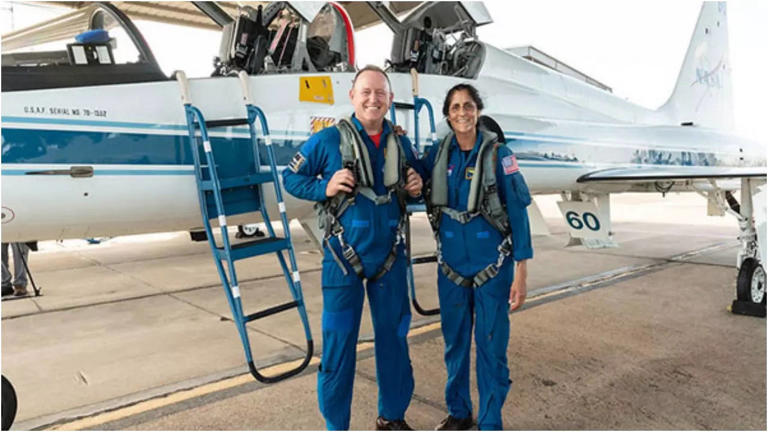Sunita Williams Third Space Mission Aborted 24
Sunita Williams Third Space Mission Aborted
A problem arose with Boeing’s Starliner, which was scheduled to launch astronaut Sunita Williams back into space. The launch was scheduled to take place at 8:04 a.m. in India from the Kennedy Space Center in Florida. But they were forced to postpone it barely 1.5 hours before takeoff. NASA said there was an issue with one of the oxygen control valves, which is why they concluded it was not safe to proceed, and hence the Sunita Williams Third Space Mission was aborted. Williams and NASA’s Barry Wilmore, who were scheduled to travel to the International Space Station, were fortunate to escape the spacecraft without incident.

Follow our Digiknowledge.co.in page for the latest updates about technology, bikes, cars, sports, lifestyle, and many more.
Sunita Williams space journey till now
Skilled astronaut Sunita Williams has bravely and expertly explored space, leaving a lasting legacy on human space exploration. Williams began her space adventure as a member of NASA’s astronaut corps. She was born in Euclid, Ohio, USA, on September 19, 1965.
As a flight engineer, she completed her first major mission in 2006 on the Space Shuttle Discovery. Her four spacewalks during this voyage demonstrated her extraordinary talent and fortitude in the harsh environment of space.
Williams became just the second woman to command the International Space Station (ISS) and broke records for the longest solo mission by a woman in 2012 when she took charge of Expedition 33. She received a lot of praise for her leadership and commitment during this expedition.
Williams has accumulated an enormous amount of space time over her career, conducting a multitude of experiments and furthering our understanding of extraterrestrial life. Her trip encourages future generations to aim high, which embodies the spirit of discovery. Williams keeps raising the bar for human achievement in the last frontier and serving as a source of inspiration.
Some focus on Boeing’s commercial space flight
In the context of NASA’s Commercial Crew Program, Boeing’s launch marks a noteworthy turning point in the history of commercial space flight. If Boeing had been successful in entering this market, it would have given NASA more options for moving personnel to and from the International Space Station (ISS).
Boeing is the second-biggest participant in this space, behind SpaceX.
In addition to showcasing Boeing’s spacecraft capabilities, the mission sought to confirm the viability of NASA’s plan to collaborate with private companies on personnel transportation requirements. Through the privatization of these services, NASA may be able to cut expenses and direct its resources toward other audacious objectives related to space exploration.
Furthermore, by pushing the boundaries of technology and promoting healthy competition in the space industry, Boeing’s involvement in the Commercial Crew Program encourages innovation. NASA benefits from flexibility and redundancy when there are numerous providers on the market, which reduces the risks associated with depending solely on one transportation method.
All things considered, the launch of Boeing signifies a turning point in the development of space exploration and a move toward a low-Earth orbit access model that is more economically driven.
In the face of difficulties in the aviation industry and criticism of its space division, namely with reference to the Starliner spacecraft’s development, prior setbacks in Boeing’s launch have clouded the company’s reputation.
The launch of the Starliner was delayed until 2019 due to multiple setbacks, which had originally scheduled it for an unmanned test flight in 2015. An internal clock fault brought on by software bugs during this postponed test led to excessive thruster firings, which burned fuel and kept the capsule from reaching the space station.
After propulsion system problems, a second attempt at launch, originally scheduled for August 2021, was postponed until May 2022. Even after the spacecraft’s cooling system and several of its engines failed, questions remained about the Starliner’s overall performance.
What was the aim of the space missions undertaken by Sunita Williams?
In order to replace a critical part that feeds power from the space station’s solar arrays to its systems, Williams and Hoshide carried out three spacewalks during their expedition. Furthermore, they fixed an ammonia leak on one of the station’s radiators, showcasing their proficiency and commitment to keeping the International Space Station operational.
How long has Sunita spent in space?
Williams worked as a researcher and explorer within the orbiting laboratory for four months. On November 18, 2012, she made her landing in Kazakhstan following a 127-day stay in orbit.
Who accompanied Sunita Williams on her space mission?
Astronaut Williams, who is of Indian descent, will be traveling on the Crewed Flight Test mission, which is the Starliner’s maiden voyage to the International Space Station, with colleague Barry “Butch” Wilmore.




